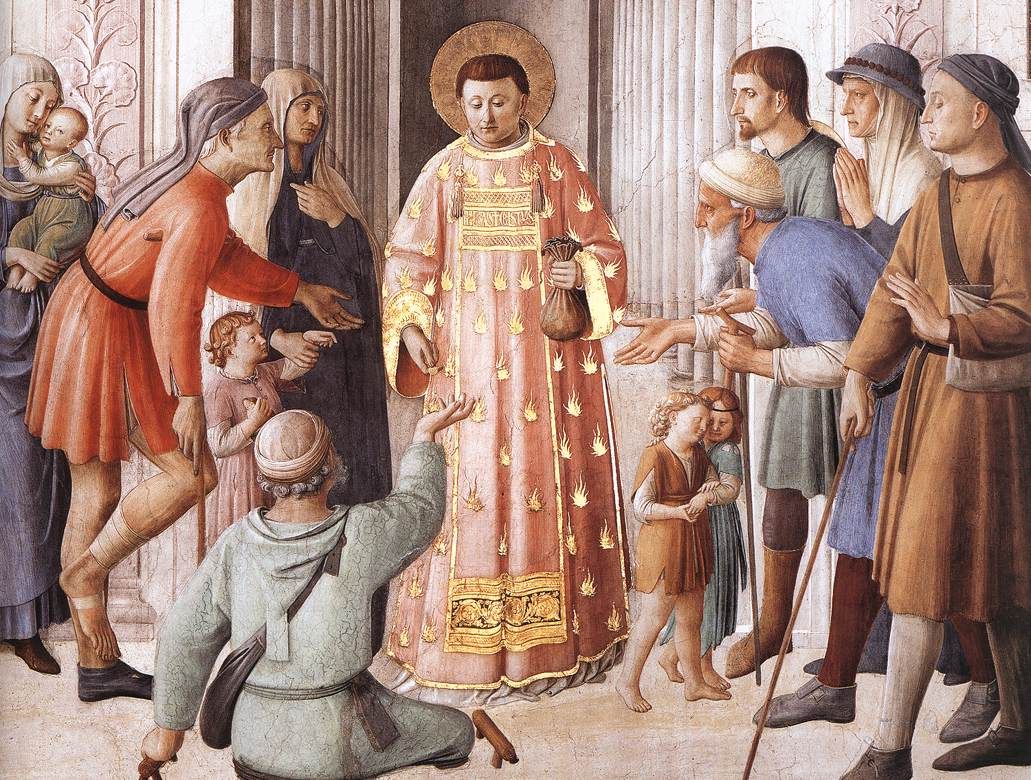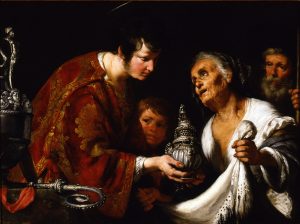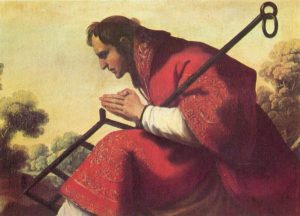
St. Lawrence was a martyr and a deacon of the early Church. Lawrence is traditionally believed to have been born at Huesca, Spain, in the year 225. Huesca is located in what is now northeastern Spain, in the region of Aragon. His parents are also believed to have been martyred, but their stories are lost to history. Lawrence apparently met the man who would become Pope Sixtus II while still living in Spain. This man, whose name prior to becoming Pope is not known, was a well-known teacher of Greek origin.
MOVE TO ROME, APPOINTMENT AS ARCHDEACON
Both men at some point came to Rome. There, in the summer of 257, this esteemed teacher became Pope Sixtus II. Lawrence, at the young age of thirty-two, was chosen to be one of seven deacons of the Roman Church. He was also selected as archdeacon, or the head of the deacons, and the care of the church treasury and the distribution of alms was entrusted to him.
In that same year 257, the Emperor Valerian announced an edict directly against Christians. The new law required them to take part in pagan rites and it also outlawed their assemblies of worship for Mass. The following summer the Emperor further ordered the arrest and execution of all deacons, priests, and bishops. On August 6, 258, Sixtus defied the Emperor and gathered together the faithful in the catacombs of St. Callistus, beneath the city of Rome. He was arrested and beheaded. As the pontiff was being lead to his death, Lawrence was filled with grief that he could not join his teacher in martyrdom. Sixtus told Lawrence that he would follow him in martyrdom in just three days, filling him with joy at the prospect of imitating the Lord in His self-sacrificial love.

FOLLOWING THE POPE IN MARTYRDOM
The prefect of Rome, knowing that Lawrence was the custodian of the valuables of the Church, ordered him to produce them to be confiscated. Lawrence requested three days time to gather the items together. He promptly sold the valuable items belonging to the Church. He then gathered together the outcasts of society – the lame, the poor, orphans and other suffering people. He distributed the proceeds to these needy people. On the third day, Lawrence appeared before the prefect with this pitiful group of people and presented them to the prefect as “the treasures of the Church”. The prefect was not amused that he did not receive the valuables. When he again demanded that the Church treasures be handed over, Lawrence stated that these needy people were the treasures of the Church. Enraged at this impertinence, the prefect ordered Lawrence to death by being roasted slowly on a gridiron, or iron rack. Lawrence was stripped of his clothing and roasted over hot coals. He endured his agony with extraordinary good humor, even suggesting to his executioner that he be turned over, since he was “done on one side”! Before he died, he prayed aloud for the conversion of Rome from its paganism to the Church. Some of the influential faithful obtained his body and buried it properly.
A PATRON FOR MANY

Most of what we know about the life of St. Lawrence takes place in the last week of his life. The accounts of his life and death were referred to by fourth and fifth century Saints and Doctors of the Church Ambrose, Augustine, and Jerome, as well as by their contemporary the poet Prudentius. Countless prayer requests made at his tomb were said to have been granted through his intercession, many of which were compiled by St. Gregory of Tours in the sixth century. Prudentius recorded that it was the death of Lawrence that prompted the downfall of pagan idolatry in Rome. Devotion to St. Lawrence as a great example of heroic faith and as a powerful intercessor spread quickly throughout the Roman Empire. The Emperor Constantine in the fourth century had a chapel built at the site of Lawrence’s tomb, which was replaced later by the Basilica di San Lorenzo fuori le Mura or St. Lawrence-Outside-the-Walls. There is also a basilica bearing his name at the site of his martyrdom, and the actual gridiron upon which he died is kept at San Lorenzo in Lucina. St. Lawrence’s feast day of August 10 is celebrated worldwide and his name is included with a number of other early Church martyrs in the Roman Canon of the Mass. St. Lawrence is also revered in the Eastern Orthodox and Anglican churches. Among his dozens of patronages include brewers, butchers, cooks, and protection from fire. After Sts. Peter and Paul, he is the third patron of Rome, and he is especially called upon by deacons, who also have the responsibility to care for the “treasures of the Church”.
